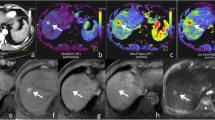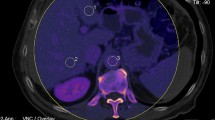Abstract
Purpose.
The aim of this study was to compare the performance of double-contrast magnetic resonance imaging (DC-MRI) with the sequential use of superparamagnetic iron oxide (SPIO) and gadolinium-diethylenetriaminepentaacetic acid (Gd-DTPA) contrast agents compared with unenhanced MRI and SPIOenhanced MRI (SPIO-MRI) in the study of the cirrhotic liver. Special attention was paid to cases in which alterations of liver uptake and distribution of the SPIO contrast medium [SPIO-liver uptake and distribution alterations (SPIO-LUDA)] could lead to diagnostic errors at SPIO-MRI.
Materials and methods.
We used DC-MRI to study 67 patients suffering from hepatic cirrhosis and on a waiting list for liver transplant. The study was performed with a 1.5-Tesla device and characterised by three phases: the first phase without contrast material (unenhanced MRI), the second after the administration of ferumoxides (SPIO-MRI), and the third, a double-contrast study following the injection of a bolus of paramagnetic contrast material (DC-MRI). The sensitivity of unenhanced MRI, SPIOMRI and DC-MRI in identifying and characterising hepatic focal lesions was assessed, together with the diagnostic increment of one technique with respect to the others. The gold standard was histological confirmation in 38 cases and clinical–radiological follow-up in all cases. Liver function, kidney function, blood tests and urinalysis were performed in all patients 24–48 h before and after the MRI examination.
Results.
In 14/67 cases (20.8%), SPIO-LUDA were present, which posed a limitation to the SPIO-MRI examination. Focal lesions were absent in 44 patients, and the action of the ferumoxides was reduced by the presence of SPIO-LUDA in nine cases. There were five cases of confluent fibrosis, two of decompensated cirrhosis, one of vascular thrombosis, and one of scarring in a patient who had undergone hepatic resection for hepatocellular carcinoma (HCC). In all these cases, completion of the MR examination with the DC technique clarified the MR picture, confirming the absence of focal lesions. Twenty-three patients had a total of 68 lesions, which consisted of 37 dysplastic nodules (DN), 19 HCC nodules, two relapses of HCC following chemoembolisation, two HCC associated with portal thrombosis, one cancer-cirrhosis, two angiomas and five small cysts. SPIO-LUDA were present in five patients, thus limiting the identification, characterisation or assessment of the real size of the lesions. SPIO-LUDA were the result of vascular thrombosis in one case and fibrosis in four cases. In all of these cases, DC-MRI proved useful for diagnosis. The sensitivity of unenhanced MRI, SPIO-MRI and DC-MRI for lesion detection was 57.3%, 67.6% and 75%, respectively. The results obtained in the characterisation of the lesions were 20.5%, 63.2% and 73.5% for unenhanced MRI, SPIO-MRI and DC-MRI, respectively. The diagnostic increment of SPIO-MRI over unenhanced MRI for lesion identification and characterisation was 9% and 42.7%, respectively, whereas the diagnostic increment of DC-MRI over SPIO-MRI was 7.4% and 10.3%, respectively.
Conclusions.
In our study, the combined use of two contrast agents, negative and positive, provided greater diagnostic confidence and caused no side effects in the patients.
Similar content being viewed by others
Author information
Authors and Affiliations
Corresponding author
Rights and permissions
About this article
Cite this article
Macarini, L., Marini, S., Milillo, P. et al. Double-contrast MRI (DC-MRI) in the study of the cirrhotic liver: utility of administering Gd-DTPA as a complement to examinations in which SPIO liver uptake and distribution alterations (SPIO-LUDA) are present and in the identification and characterisation of focal lesions. Radiol med 111, 1087–1102 (2006). https://doi.org/10.1007/s11547-006-0107-3
Received:
Accepted:
Published:
Issue Date:
DOI: https://doi.org/10.1007/s11547-006-0107-3




